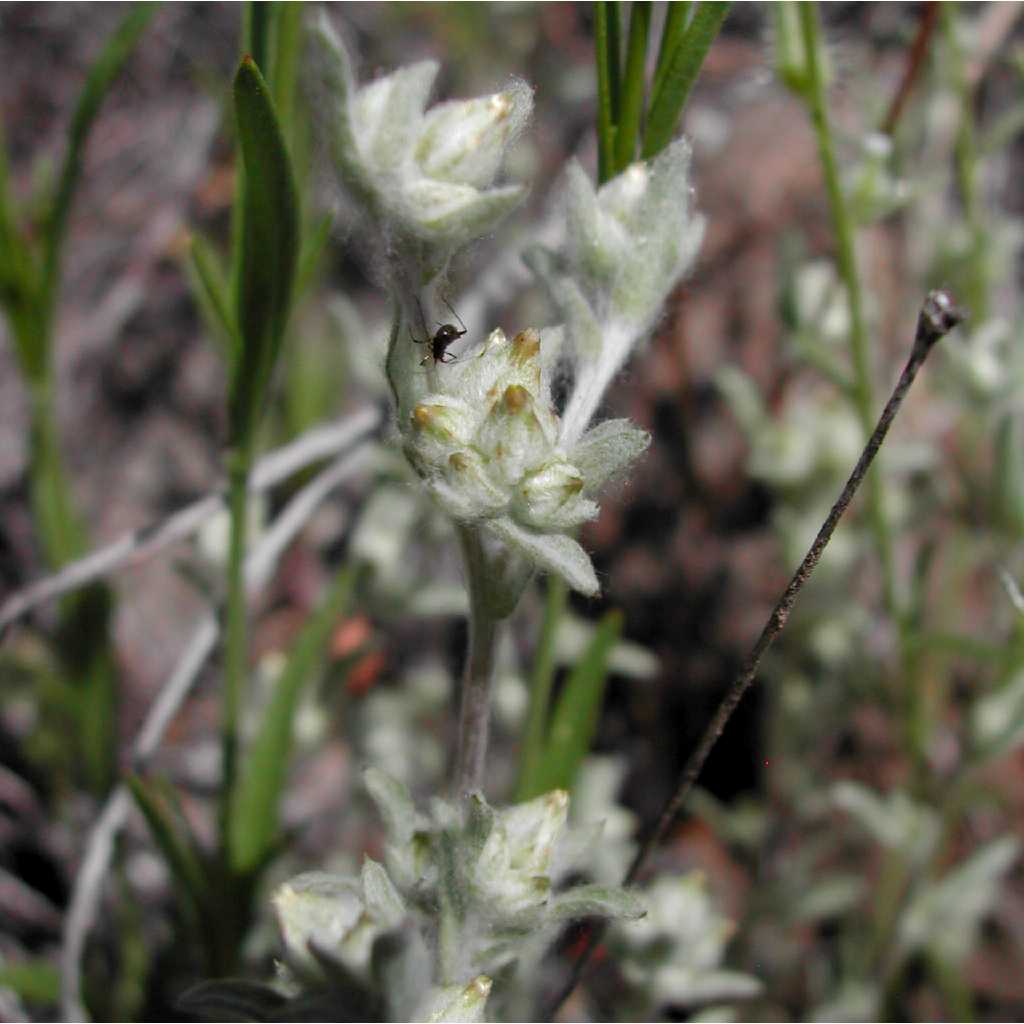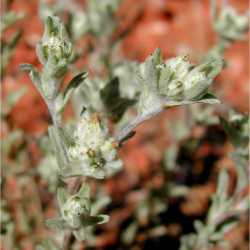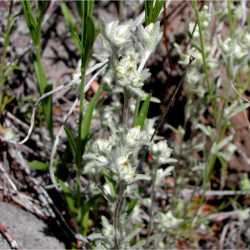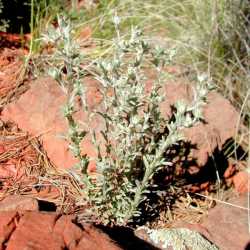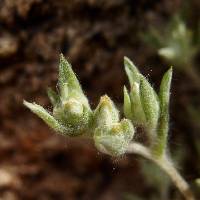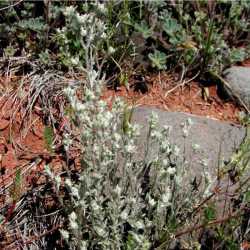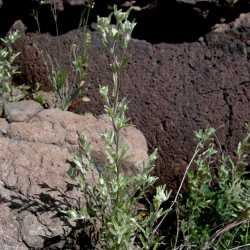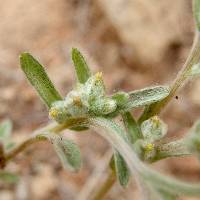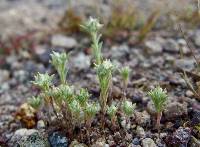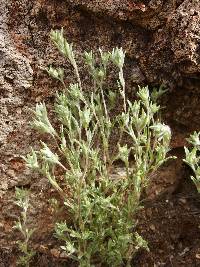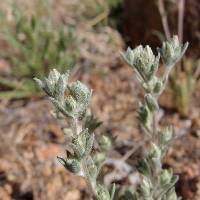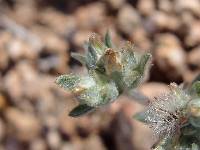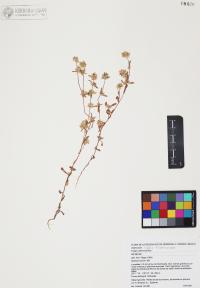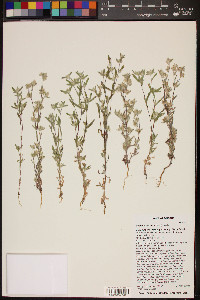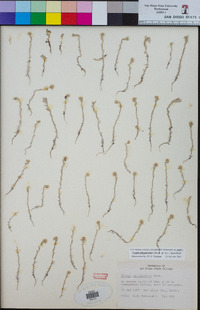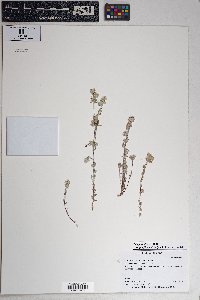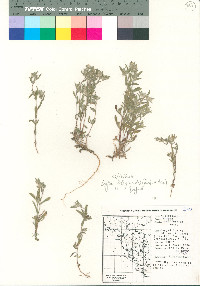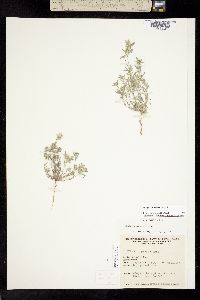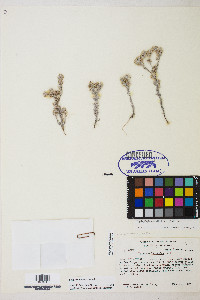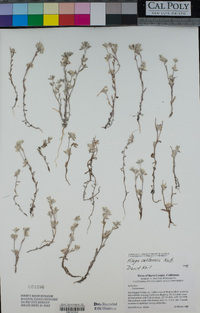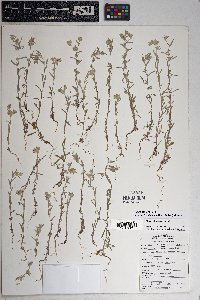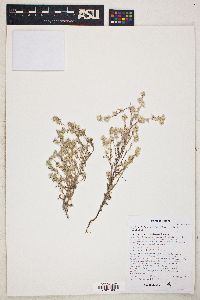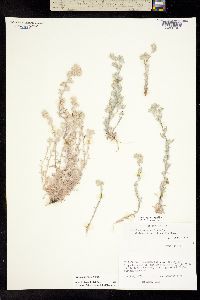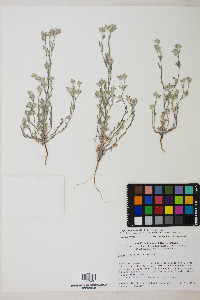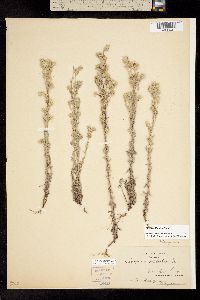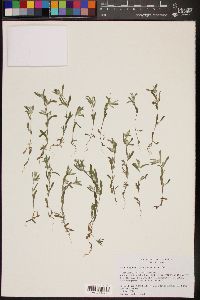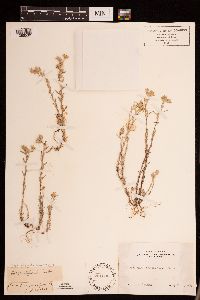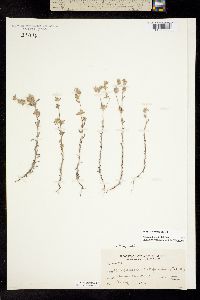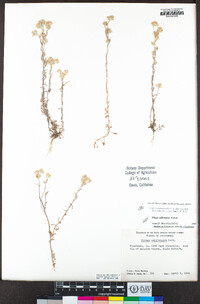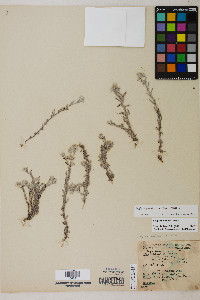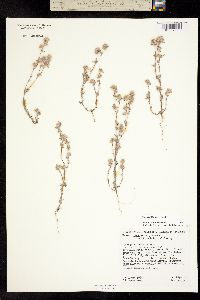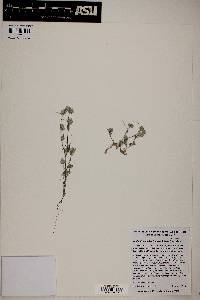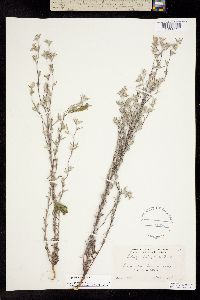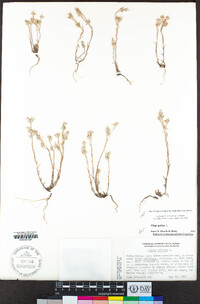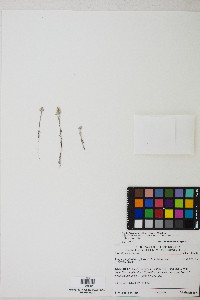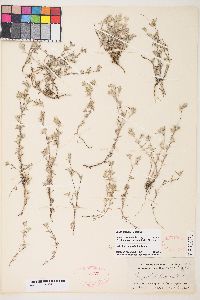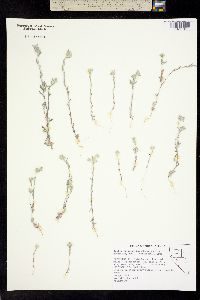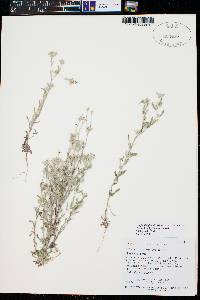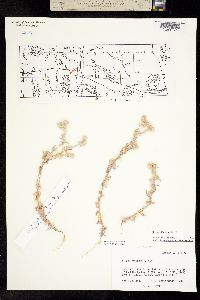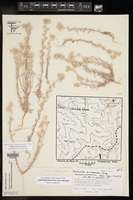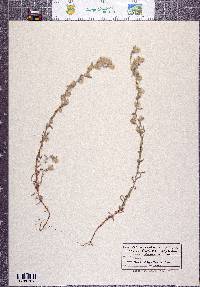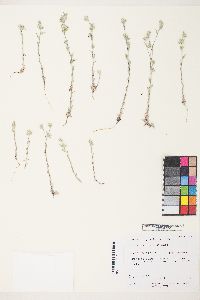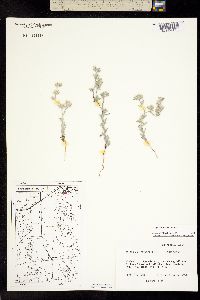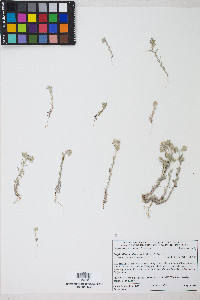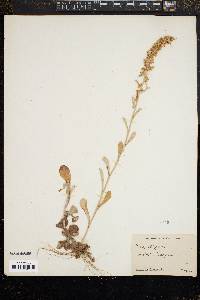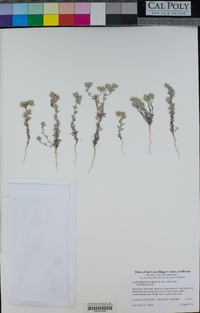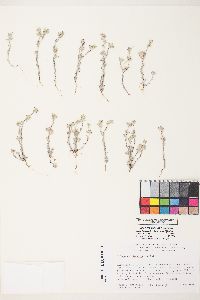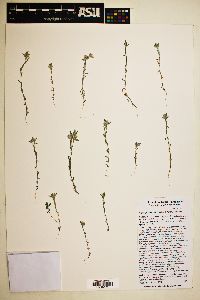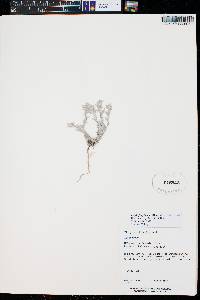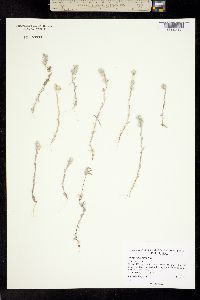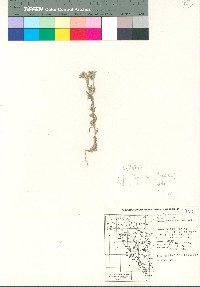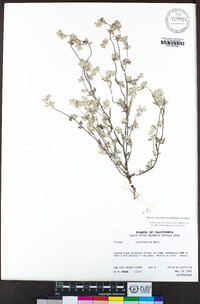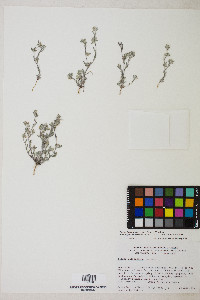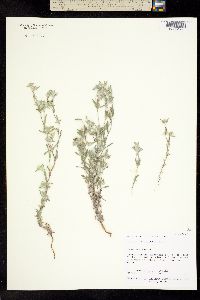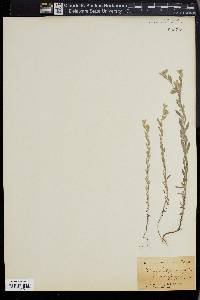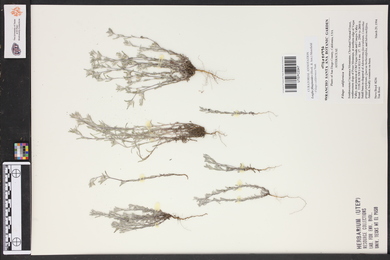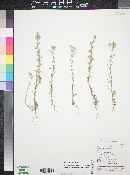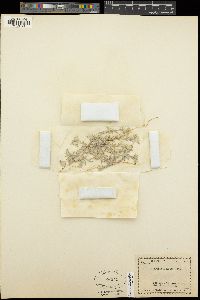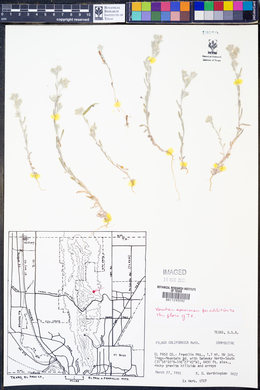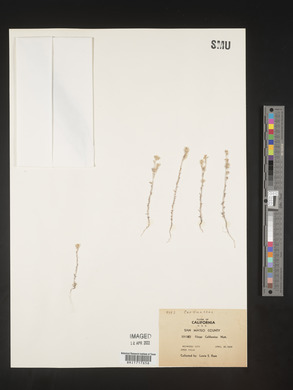Logfia filaginoides
|
|
|
|
Family: Asteraceae
California cottonrose, more...California False Cotton-Rose, California fluffweed
[Filago californica Nutt., moreLogfia californica (Nutt.) Holub, Oglifa californica (Nutt.) Rydb.] |
Plants 1-30(-55) cm. Stems 1(-7), typically ± erect; branches leafy between proximal forks, remaining grayish to greenish, arachnoid-sericeous. Leaves mostly oblanceolate, largest 10-15(-20) × 2-3(-4) mm, pliant; longest capitular leaves 1-2(-3) times head heights, mostly acute. Heads mostly in glomerules of 2-4 in racemiform, paniculiform, or distally dichasiiform arrays, ± pyriform, largest 3.5-4.5 × 2.5-3 mm. Phyllaries 0, vestigial, or 1-4, unequal, ± like paleae. Receptacles ± fungiform, mostly 0.6-0.7 mm, heights 0.7-0.9 times diams. Pistillate paleae (except innermost) 7-13 in 2(-3) series, spirally ranked, loosely saccate, incurved 20-60°, somewhat gibbous, not galeate, longest 2.7-3.3 mm, distal 15-30% of lengths glabrous abaxially; bodies ± cartilaginous, ± terete; wings prominent. Innermost paleae ± 5, spreading in 1 series, pistillate. Pistillate florets: outer 7-13 epappose, inner 14-35 pappose. Bisexual florets 4-7; corollas 1.9-2.8 mm, lobes mostly 4, bright reddish to purplish. Cypselae: outer nearly straight, ± erect, compressed, mostly 0.9-1 mm; inner mostly papillate; pappi of 17-23+ bristles falling in complete or partial rings, 1.9-3 mm. 2n = 28. Flowering and fruiting mid Feb-early Jul. Mediterranean climates: open slopes, flats, diverse substrates (including serpentine), old disturbances (chaparral burns) or seasonally moist sites, or warm deserts: protected slopes or higher elevations, among rocks, boulders (often granitic), less disturbed; 0-1800(-2000) m; Ariz., Calif., Nev., N.Mex., Tex., Utah; Mexico (Baja California, Baja California Sur, Sonora). Long known as Filago californica, Logfia filaginoides is relatively common in the Californian Floristic Province south of Humboldt County, California, to northern Baja California Sur (including Channel Islands, and Angel de la Guarda, Cedros, and Guadalupe islands in Mexico). Eastward, it is scattered to southwestern Utah and western Texas. An 1893 gathering labeled 'Blue Lakes, Snake Plains' is of uncertain origin.
Wiggins 1964, Kearney and Peebles 1969 Duration: Annual Nativity: Native Lifeform: Forb/Herb General: Erect or ascending annual 5-35 cm tall with leafy lanate stems. Leaves: Numerous at base of stems, narrowly oblanceolate, 1-2.5 mm wide, 8-15 mm long, acute at apex, narrowed to slender petiole, at first lanate then glabrate with age, upper leaves subtending axillary and terminal glomerules linear oblong, mostly less than 5 mm long, moderately lanate. Flowers: Heads ovoid-turbinate, 3-4 mm long, outermost bracts ovate to lance-ovate, sterile, lanate dorsally, those immediately interior lance-ovate, shallowly boat shaped, lanate dorsally, tipped with hyaline appendage about one-half as long as body, subtending each filiform, pistillate, epappose flower; innermost bracts lance-linear or oblong, membranous, nearly flat, tips extend 0.2-0.3 mm beyond lanate parts of outer bracts; flowers immediately interior to membranous bracts fertile. Fruits: Cypselae of outer flowers smooth, interior with minutely pappose. Ecology: Found on open slopes and flats from 500-7,000 ft (152-2134 m); flowers March-May. Notes: The taxonomy of this plant is under consideration. You probably know this plant as Filago californica. The globose flowering heads help to identify this genus, hence the name cottonrose. Ethnobotany: Unknown Etymology: Logfia is an anagram of the genus Filago, while californica means of or from California. Synonyms: Filago californica, Oglifa californica Editor: SBuckley, 2010 FNA 2006, Jepson 2012, Kearney and Peebles 1969 Duration: Annual Nativity: Native Lifeform: Forb/Herb General: Herbaceous annuals, to 55 cm tall, stems 1-7, typically erect, branches leafy between the proximal forks, remaining grayish to greenish, surfaces arachnoid-sericeous. Leaves: Oblanceolate, the largest 10-20 mm long and 2-4 mm wide, blades pliant, tips mostly acute. Flowers: In small, cottony, white heads with pistillate and bisexual florets, heads pyramid-like, the largest 3.5-4.5 mm long and 2.5-3 mm wide, pistillate florets with the outer 7-13 epappose, the inner 14-35 pappose, bisexual florets 4-7, the corollas 1.9-2.8 mm long, with 4 lobes, the bright reddish to purplish, phyllaries absent, vestigial, or 1-4, if present unequal, receptacles fungiform, mostly 0.6-0.7 mm long, pistillate paleae 7-13 in 2-3 series, spirally ranked and incurved 20-60-, somewhat gibbous, the longest 2.7-3.3 mm long, glabrous below, the bodies cartilaginous, terete, with prominent wings, the innermost paleae 5, pistillate, spreading in 1 series, heads borne in glomerules of 2-4 in raceme or panicle like arrays. Fruits: Cypselae, the outer nearly straight, erect, and compressed, mostly 0.9-1 mm long, the inner mostly papillate, pappi of 17-23 or more bristles falling in complete or partial rings, 1.9-3 mm long. Ecology: Found on diverse substrates including serpentine or granitic soils, on open slopes, flats, old disturbances, chaparral burns, warm deserts, or seasonally moist sites, protected slopes or higher elevations, among rocks, boulders, and less disturbed areas, Distribution: Arizona, California, Nevada, New Mexico, Texas, Utah Ethnobotany: Unknown. Etymology: Logfia is apparently an anagram of the genus Filago, and filaginoides means resembling genus Filago. Synonyms: Gnaphalium filaginoides Editor: LCrumbacher2012 |
|
|
|

